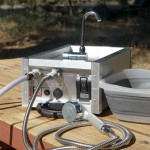How to Measure a Kitchen Sink
Measuring a kitchen sink is a crucial step when planning for a kitchen renovation or replacement. Accurate measurements ensure that the new sink fits perfectly within the existing countertop and cabinetry. Here's a comprehensive guide on how to measure a kitchen sink effectively:
1. Determine the Sink Type
Identify the type of kitchen sink you have or intend to install. Common sink types include single-bowl, double-bowl, and farmhouse sinks. Each type has its own unique installation requirements and measurements.
2. Measure the Length and Width
Use a measuring tape or ruler to measure the length and width of the sink basin from edge to edge, excluding the sink rim or lip. Note down these dimensions in inches or centimeters.
3. Measure the Depth
Next, measure the sink's depth from the top rim to the bottom of the basin. This measurement determines the sink's capacity and how much water it can hold.
4. Determine the Rim or Lip Thickness
Measure the thickness of the sink's rim or lip, if applicable. This measurement ensures that the sink fits flush with the countertop and prevents water from leaking beneath.
5. Measure the Undermount or Drop-In Size
Depending on the type of sink, consider measuring its undermount or drop-in size. Undermount sinks need a hole in the countertop slightly smaller than the sink's overall dimensions. Drop-in sinks rest on the countertop, so the measurement should include the sink's outer edge.
6. Measure the Faucet Holes
If your sink has pre-drilled faucet holes, measure the distance between the center of each hole. This measurement ensures compatibility with the new faucet.
7. Measure the Overall Height
For undermount sinks, measure the overall height from the bottom of the sink to the top of the lip. This measurement determines how far the sink will protrude below the countertop.
8. Measure the Drain Hole Diameter
Measure the diameter of the drain hole to ensure compatibility with the new drain assembly and disposal unit.
9. Consider Additional Features
If the sink has additional features such as drainboards or built-in cutting boards, measure these components as well. This will ensure a seamless integration with the surrounding countertop.
10. Check Manufacturer's Specifications
Always refer to the manufacturer's specifications for exact dimensions and installation requirements. Different sinks and models may have variations in measurements.
Tips:
- Use a straight edge or ruler for accurate measurements.
- Take multiple measurements in different areas to ensure precision.
- Draw a sketch or take a photo of the sink with measurements for reference.
- Consider the space available beneath the sink for plumbing connections and storage.
- If you're unsure about any measurements, consult a professional kitchen designer or plumber.

3 Ways To Measure A Kitchen Sink Wikihow

How To Measure A Kitchen Sink The Home

How To Measure For A Kitchen Sink In 5 Steps Modern Living

A Practical Guide To Measure The Size Of Kitchen Sink

3 Ways To Measure A Kitchen Sink Wikihow

Measure A Kitchen Sink Temecula Handyman

3 Ways To Measure A Kitchen Sink Wikihow

How To Measure A Kitchen Sink The Home

Measure A Kitchen Sink Temecula Handyman

How To Measure A Kitchen Sink The Home







